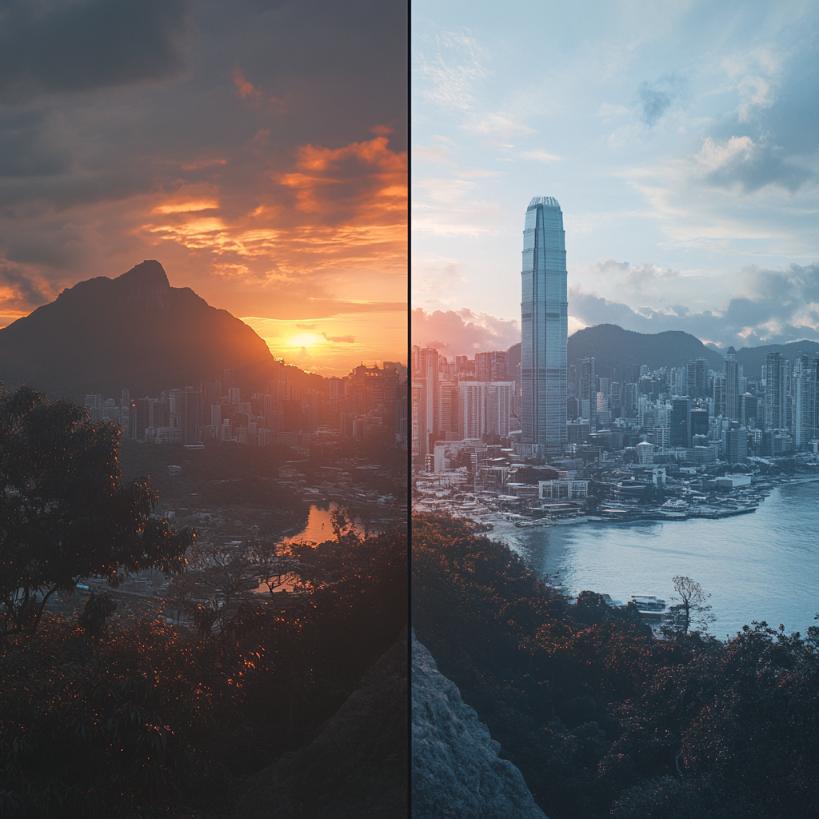Wipe Transition in Film? A Complete Guide to this Classic Editing Technique
Introduction
Film transitions are crucial in guiding the audience from one scene to another, helping create a smooth and engaging cinematic experience. Whether transitioning between different locations, time periods, or points of view, editing techniques play a vital role in maintaining the flow of a film. Among these techniques, the wipe transition stands out as a unique and visually striking method.
Unlike cuts or fades, a wipe transition “wipes” one shot away, replacing it with another as a line moves across the screen. This technique has a long history in cinema, adding style and distinction to many iconic films. From classic Hollywood movies to modern sci-fi blockbusters, wipe transitions continue to offer filmmakers a creative way to shift between scenes while enhancing the visual storytelling.
What is a Wipe Transition?
A wipe transition is a type of film editing technique where one shot is replaced by another through a moving line or shape that “wipes” across the screen. Unlike the more common cut or dissolve, which simply switches between two scenes, a wipe transition creates a dynamic and stylized movement. As the wipe progresses, the new shot gradually pushes the previous one off-screen, creating a clear visual shift. This transition can move in different directions, offering various effects to fit the scene.
The most common variations of the wipe transition include:
- Horizontal wipes, where the new shot slides in from the left or right.
- Vertical wipes, where the transition moves up or down.
- Diagonal wipes, which combine both horizontal and vertical movements to slide across the screen at an angle.
- Iris wipes, which feature a circular wipe, expanding or contracting from the center of the frame.

Each variation offers filmmakers creative freedom to transition between scenes in a way that matches the tone and flow of the story. While wipe transitions are less frequently used in modern films, they remain a powerful tool for adding a unique visual element, often evoking a sense of nostalgia or adventure when employed effectively.
History and Evolution of the Wipe Transition
The wipe transition has its roots in early cinema, particularly during the silent film era of the early 20th century. Back then, filmmakers were experimenting with new ways to move between scenes and enhance storytelling. The wipe transition offered a novel solution, allowing directors to emphasize shifts in time, location, or narrative focus with a clear visual cue. It quickly became a popular editing technique, seen in films from the 1920s and 1930s.
As film technology evolved, so did the use of wipe transitions. One of the most famous examples of this transition can be found in Akira Kurosawa’s films, particularly The Hidden Fortress (1958), which influenced many filmmakers, including George Lucas. In the 1970s, Lucas famously incorporated wipe transitions into his Star Wars saga, making them a signature visual element of the franchise. Lucas used wipes to evoke a sense of nostalgia for classic adventure serials, while also giving the films a dynamic, fast-paced feel. In Star Wars, horizontal and vertical wipes, as well as more complex variations, were used to transition between galaxies, characters, and storylines, creating an immersive cinematic experience.
The wipe transition was also frequently used in older science fiction, fantasy, and adventure films where a grand shift in time or space was needed. As these genres often dealt with large-scale, imaginative settings, wipes helped bridge scenes in a way that felt fluid and natural to the audience. However, with the rise of digital editing and more subtle transitions, the use of wipes became less common in mainstream films from the 1980s onward.
Despite their reduced usage today, wipe transitions remain a valuable tool for filmmakers who want to convey a certain retro style or add a layer of visual drama. The technique’s ability to smoothly shift from one world to another continues to resonate in both classic and modern cinema.
Types of Wipe Transitions
Wipe transitions come in various forms, each offering a different way to transition between scenes while maintaining a dynamic visual flow. Here are some of the most common types:
Horizontal Wipes: This is the most traditional type of wipe, where a line moves from one side of the screen to the other, usually left to right or right to left. It’s often used to indicate a passage of time or a shift in location, as seen in many classic adventure films.
Vertical Wipes: In this variation, the transition moves from the top of the screen to the bottom or vice versa. Vertical wipes can add a sense of progression or reveal a dramatic shift in perspective, especially when moving between large-scale scenes.
Iris Wipes: Popularized in early cinema, particularly in silent films, the iris wipe involves a circular motion where one scene closes in or opens out from the center of the screen. This wipe is often used for dramatic or emotional transitions, giving the sense of zooming in or out of a scene.
Clock Wipes: As the name suggests, this wipe moves in a circular, clock-like motion. This type of transition is less common today but was used extensively in older films to create a playful or whimsical effect.

In modern filmmaking, these transitions are rarely used but still find their place in genres like sci-fi, fantasy, and homage films. Digital editing tools allow for more complex and creative adaptations of the wipe transition, enabling filmmakers to blend multiple types or experiment with entirely new shapes and movements. While often seen as retro, wipe transitions can still deliver impactful scene changes when used thoughtfully.
Why and When to Use a Wipe Transition
Wipe transitions are a powerful tool in filmmaking, best utilized when a clear and visual shift in time, location, or narrative is required. This editing technique works particularly well in scenes that involve significant changes, such as moving between distant locations, jumping forward in time, or transitioning between different storylines or characters. For example, in a film that spans multiple locations, a wipe transition can seamlessly guide the viewer from one setting to another, helping maintain the flow of the narrative.
One of the strengths of the wipe transition is its ability to create a sense of continuity while also signaling a clear shift. In action or adventure films, a wipe transition can be used to jump between simultaneous events, giving the audience a sense of urgency or movement. Similarly, in historical or fantasy genres, wipes are often employed to transition between different time periods or realms, enhancing the storytelling by visually guiding viewers through major shifts in the narrative.
However, wipe transitions should be used sparingly and with intention. Overusing them can make a film feel dated or overly stylized, especially in modern cinema, where smoother and more subtle transitions like cuts and dissolves are more common. While wipes are a staple of classic filmmaking, they can draw too much attention if used excessively, distracting viewers from the story.
The key to using wipe transitions effectively lies in subtlety. When used thoughtfully and in moderation, they can enhance a film’s visual language and storytelling. For instance, a horizontal wipe may signal the passage of time, while an iris wipe can focus attention on a particular character or moment. In the right context, wipe transitions can add flair and nostalgia to a film, but maintaining balance is crucial to ensuring they support, rather than overpower, the overall cinematic experience.
Examples of Wipe Transitions in Iconic Films

Wipe transitions have been used effectively in many iconic films, helping to shape the visual storytelling of each movie. Here is a list of some samples:
1. Indiana Jones and the Raiders of the Lost Ark (1981)
In Indiana Jones and the Raiders of the Lost Ark, director Steven Spielberg used wipe transitions in a style reminiscent of the Star Wars saga. The wipes were often employed to transition between exotic locations, capturing the essence of the old adventure serials that inspired the film. These transitions helped create a fast-paced, globe-trotting narrative as Indiana Jones raced against time to recover the Ark of the Covenant.
2. Flash Gordon (1980)
Flash Gordon, known for its colorful, campy style, extensively used wipe transitions to match its playful, adventurous tone. The film’s retro-futuristic aesthetic was enhanced by these transitions, which were inspired by the sci-fi serials of the 1930s. The use of wipes between action sequences and scenes in different worlds amplified the comic-book feel of the movie.
3. Batman (1966 TV series and movie)
The 1966 Batman TV series and its movie adaptation famously used wipe transitions to heighten the campy and dynamic energy of the show. The wipes often appeared between action sequences and were accompanied by iconic onomatopoeic words like “BAM!” or “POW!”, adding to the comic book style and playful atmosphere. These transitions reinforced the vibrant, exaggerated tone of the series.
Conclusion
Wipe transitions are a timeless and versatile tool in film editing, offering a unique way to visually shift between scenes. While less commonly used in modern cinema, their ability to signify changes in time, location, or narrative remains powerful. From their origins in early films to their use in iconic movies like Star Wars, wipe transitions have proven their value in enhancing storytelling and creating memorable cinematic moments.
For filmmakers and editors, experimenting with wipe transitions can add a layer of creativity and flair to any project. Whether you’re aiming for a retro style or looking for a dynamic way to connect scenes, this classic technique offers endless possibilities. With modern editing software making it easier than ever to implement, now is the perfect time to explore how wipe transitions can elevate your visual storytelling.

